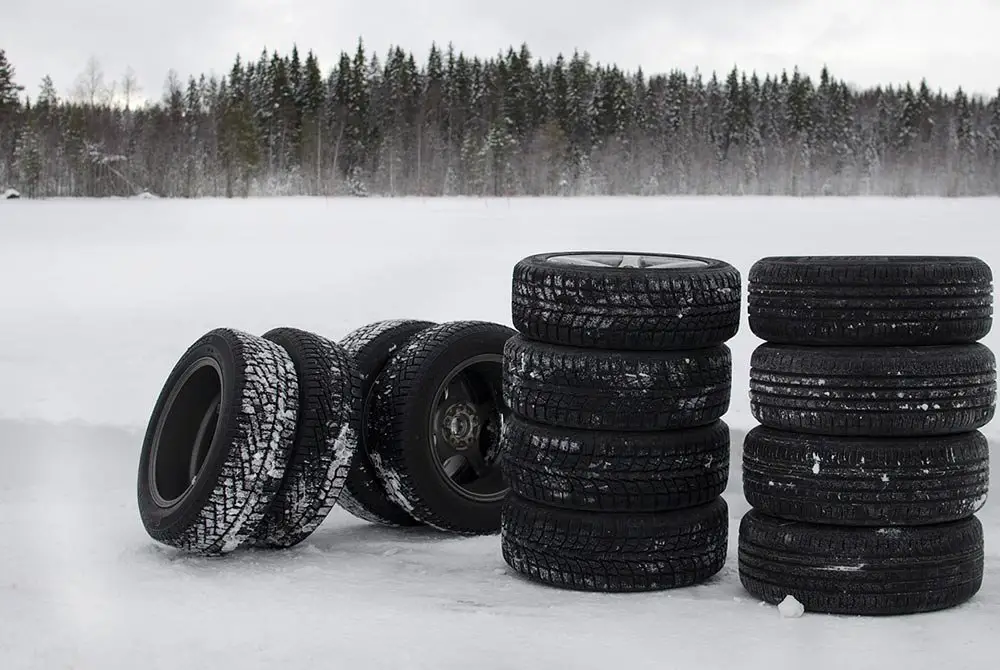Snow tires are essential for driving safely in winter weather conditions. But when to take off snow tires? That’s what this guide will help you determine. We’ll discuss why switching back to regular tires is important, how to tell if your car needs new snow tires and more. So read on and find out when to take off your snow tires!
What's in this post?
When to Take Off Snow Tires
When it comes to when to take off snow tires, there are a few factors to consider.
Generally speaking, the best time to switch back to regular tires is when temperatures consistently reach 7°C (45°F) or higher in your area. This is because the rubber compounds used in snow tires begin to harden and become less effective above this temperature.
Here are a few more tips to help you determine when it’s time to take off your snow tires:
• Check the forecast: Pay attention to the weather in your area and look for days with temperatures consistently above 7°C (45°F). This will give you an indication of when it’s safe to switch back to regular tires.
• Monitor your tire treads: Look at the treads on your snow tires and examine them for signs of wear and tear. If they’re starting to look worn down, this is a sign that it’s time to take off your snow tires.
• Ask an expert: Consult an experienced automotive technician or tire specialist if unsure. They will be able to provide you with more specific guidance on when it’s time to switch back to regular tires.
• Follow the manufacturer’s recommendations: Lastly, follow the tire manufacturer’s guidelines for when it’s time to take off your snow tires.
To conclude, when to take off snow tires is an important decision. The best time to switch back to regular tires is when temperatures consistently reach 7°C (45°F) or higher in your area, as this is when the rubber compound used in snow tires starts to harden and become less effective.
Why You Should Take Off Your Snow Tires

Removing your snow tires is mainly because they perform less well in warm weather.
The rubber compound used in snow tires starts to harden and become less flexible when the temperature rises above 7°C (45°F).
This reduces their grip on the road and can lead to decreased handling, braking, and overall performance. So, switching back to your regular tires is best if you’re driving in warm weather conditions.
How To Take Off Snow Tires

After knowing when to take off snow tires, you may wonder how to do it. Taking off your snow tires is a relatively simple process requiring no special tools or equipment. Here’s what you should do:
- Park your car on a level surface: This will ensure that the tire can be removed safely without risking injury or damage to the vehicle.
- Loosen the lug nuts: This is done using a lug wrench. Loosen each nut slightly, but do not remove them completely.
- Lift the car: You can use either a jack or a lift to lift the car off the ground enough to remove the tire. Ensure all four tires are raised evenly to avoid damaging your car.
- Remove the lug nuts: Once the car is raised, remove them and set them aside.
- Remove the tire: Grip it firmly on each side and pull it straight off. Make sure to use both hands to prevent any accidents.
- Install new tires: Once you’ve removed the snow tire, install them (if you have them) and secure them with the lug nuts.
- Lower the car: Once the new tire is in place, lower your car back to the ground and securely tighten all the lug nuts.
How to Tell if Your Car Needs New Snow Tires
Now you may know when to take off snow tires, but about the right time to buy a new one? If you’ve been driving on snow tires for a while, it’s important to check them regularly for signs of wear and tear. Here are a few things to look out for:
- Tread depth: The treads on snow tires should be at least 6/32 of an inch deep. If they’re worn down to 3/32 or less, it’s time for new tires.
- Cracks and cuts in the rubber: Any cracks or cuts in the tire can weaken its structure and reduce grip on the road.
- Uneven wear: If the treads are wearing down unevenly, it could be a sign that the tires need to be balanced or aligned.
What to Do After Taking Off Your Snow Tires

Once you’ve taken off your snow tires and switched back to your regular summer or all-season tires, there are a few other things you should do:
- Check your tire pressure: Make sure your tires are inflated to the recommended pressure for your car.
- Inspect your wheels and rims: Look for any signs of damage or wear and tear that may have occurred while using snow tires.
- Have the alignment checked: If you notice any uneven wear on the tires, it’s a good idea to get them professionally aligned.
Winter Driving Tips for Drivers With Snow Tires
If you’re still using snow tires, there are some important things to remember while driving in winter weather conditions. Here are a few tips for staying safe:
- Slow down: Speed limits are set for optimal conditions, but driving too fast on slippery roads can lead to losing control.
- Increase following distance: It takes vehicles longer to stop in icy or snowy conditions. Be sure to leave plenty of room between you and other cars.
- Avoid sudden steering and braking: Sudden and hard braking inputs can cause your vehicle to slide or spin out.
- Don’t drive through deep snow: Snow tires aren’t designed for off-road use, so it’s best to avoid driving through deep snow drifts.
Tips for Storing Snow Tires

Storing your snow tires properly can help them last longer and maintain their performance. Here are a few tips to keep in mind:
- Store in a cool and dry place: Store your tires in a garage or shed out of direct sunlight. This will help prevent the rubber from drying out and cracking.
- Rotate the tires periodically: To prevent flat spots from forming, rotate your tires every few weeks.
- Clean and inspect regularly: Clean off any dirt or debris that may accumulate on the tire and check for signs of wear and tear.
FAQs about When to Take Off Snow Tires
You may have many other questions besides knowing when to take off snow tires. Here are some of the most common ones:
Q: How long should snow tires last?
A: On average, snow tires last between 4 and 10 years, depending on the amount of use and the quality of the tire.
Q: How often should I replace my snow tires?
A: It depends on the amount of use and the condition of the treads. Replacing your snow tires every year or two is a good idea.
Q: What is the best temperature for taking off snow tires?
A: The best temperature to switch to regular tires is when temperatures consistently reach 7°C (45°F) or higher. The rubber compound used in snow tires starts to harden at this temperature and becomes less effective.
Q: Can I use my snow tires in the summer?
A: No, it’s using snow tires during the summer is not recommended. The rubber compound used in snow tires is designed to provide a better grip in cold weather. Still, it can become hard and less effective in warmer temperatures.
Q: How do I store my snow tires?
A: It’s best to store your snow tires in a cool and dry place from direct sunlight. Rotate and clean the tires regularly to prevent dirt or debris from accumulating. Additionally, inspect the tires for signs of wear and tear.





